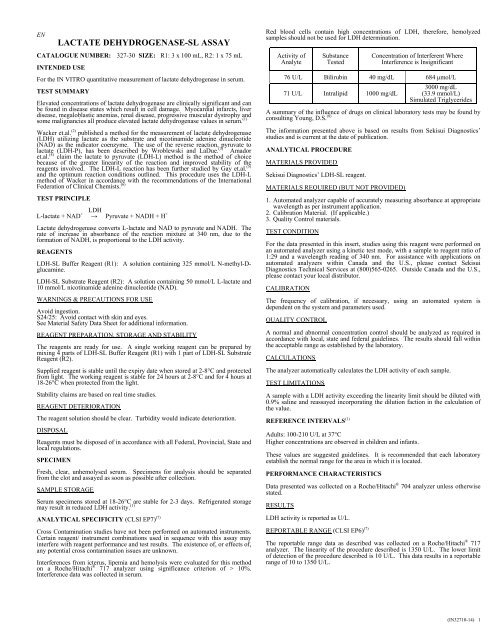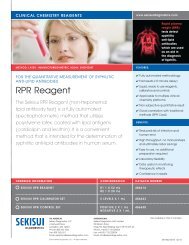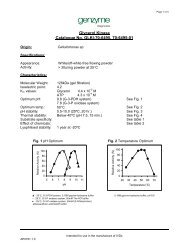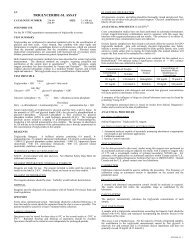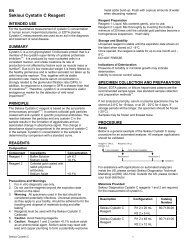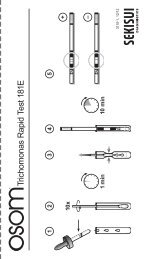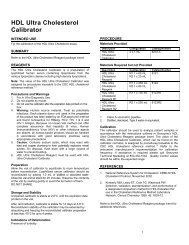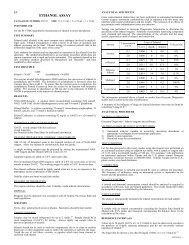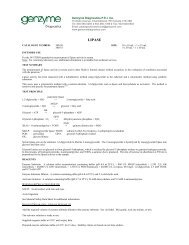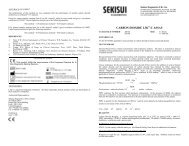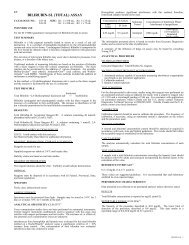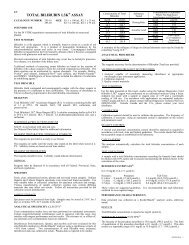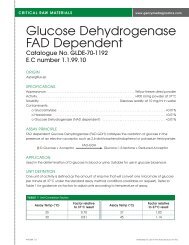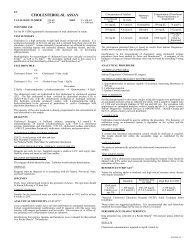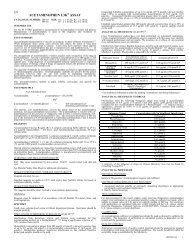LACTATE DEHYDROGENASE-SL ASSAY - Sekisui Diagnostics
LACTATE DEHYDROGENASE-SL ASSAY - Sekisui Diagnostics
LACTATE DEHYDROGENASE-SL ASSAY - Sekisui Diagnostics
Create successful ePaper yourself
Turn your PDF publications into a flip-book with our unique Google optimized e-Paper software.
EN<br />
<strong>LACTATE</strong> <strong>DEHYDROGENASE</strong>-<strong>SL</strong> <strong>ASSAY</strong><br />
CATALOGUE NUMBER: 327-30 SIZE: R1: 3 x 100 mL, R2: 1 x 75 mL<br />
INTENDED USE<br />
For the IN VITRO quantitative measurement of lactate dehydrogenase in serum.<br />
TEST SUMMARY<br />
Elevated concentrations of lactate dehydrogenase are clinically significant and can<br />
be found in disease states which result in cell damage. Myocardial infarcts, liver<br />
disease, megaloblastic anemias, renal disease, progressive muscular dystrophy and<br />
some malignancies all produce elevated lactate dehydrogenase values in serum. (1)<br />
Wacker et.al. (2) published a method for the measurement of lactate dehydrogenase<br />
(LDH) utilizing lactate as the substrate and nicotinamide adenine dinucleotide<br />
(NAD) as the indicator coenzyme. The use of the reverse reaction, pyruvate to<br />
lactate (LDH-P), has been described by Wroblewski and LaDue. (3) Amador<br />
et.al. (4) claim the lactate to pyruvate (LDH-L) method is the method of choice<br />
because of the greater linearity of the reaction and improved stability of the<br />
reagents involved. The LDH-L reaction has been further studied by Gay et.al. (5)<br />
and the optimum reaction conditions outlined. This procedure uses the LDH-L<br />
method of Wacker in accordance with the recommendations of the International<br />
Federation of Clinical Chemists. (6)<br />
TEST PRINCIPLE<br />
LDH<br />
L-lactate + NAD + → Pyruvate + NADH + H +<br />
Lactate dehydrogenase converts L-lactate and NAD to pyruvate and NADH. The<br />
rate of increase in absorbance of the reaction mixture at 340 nm, due to the<br />
formation of NADH, is proportional to the LDH activity.<br />
REAGENTS<br />
LDH-<strong>SL</strong> Buffer Reagent (R1): A solution containing 325 mmol/L N-methyl-Dglucamine.<br />
LDH-<strong>SL</strong> Substrate Reagent (R2): A solution containing 50 mmol/L L-lactate and<br />
10 mmol/L nicotinamide adenine dinucleotide (NAD).<br />
WARNINGS & PRECAUTIONS FOR USE<br />
Avoid ingestion.<br />
S24/25: Avoid contact with skin and eyes.<br />
See Material Safety Data Sheet for additional information.<br />
REAGENT PREPARATION, STORAGE AND STABILITY<br />
The reagents are ready for use. A single working reagent can be prepared by<br />
mixing 4 parts of LDH-<strong>SL</strong> Buffer Reagent (R1) with 1 part of LDH-<strong>SL</strong> Substrate<br />
Reagent (R2).<br />
Supplied reagent is stable until the expiry date when stored at 2-8°C and protected<br />
from light. The working reagent is stable for 24 hours at 2-8°C and for 4 hours at<br />
18-26°C when protected from the light.<br />
Stability claims are based on real time studies.<br />
REAGENT DETERIORATION<br />
The reagent solution should be clear. Turbidity would indicate deterioration.<br />
DISPOSAL<br />
Reagents must be disposed of in accordance with all Federal, Provincial, State and<br />
local regulations.<br />
SPECIMEN<br />
Fresh, clear, unhemolysed serum. Specimens for analysis should be separated<br />
from the clot and assayed as soon as possible after collection.<br />
SAMPLE STORAGE<br />
Serum specimens stored at 18-26°C are stable for 2-3 days. Refrigerated storage<br />
may result in reduced LDH activity. (1)<br />
ANALYTICAL SPECIFICITY (CLSI EP7) (7)<br />
Cross Contamination studies have not been performed on automated instruments.<br />
Certain reagent/ instrument combinations used in sequence with this assay may<br />
interfere with reagent performance and test results. The existence of, or effects of,<br />
any potential cross contamination issues are unknown.<br />
Interferences from icterus, lipemia and hemolysis were evaluated for this method<br />
on a Roche/Hitachi ® 717 analyzer using significance criterion of > 10%.<br />
Interference data was collected in serum.<br />
Red blood cells contain high concentrations of LDH, therefore, hemolyzed<br />
samples should not be used for LDH determination.<br />
Activity of<br />
Analyte<br />
Substance<br />
Tested<br />
Concentration of Interferent Where<br />
Interference is Insignificant<br />
76 U/L Bilirubin 40 mg/dL 684 μmol/L<br />
71 U/L Intralipid 1000 mg/dL<br />
3000 mg/dL<br />
(33.9 mmol/L)<br />
Simulated Triglycerides<br />
A summary of the influence of drugs on clinical laboratory tests may be found by<br />
consulting Young, D.S. (8)<br />
The information presented above is based on results from <strong>Sekisui</strong> <strong>Diagnostics</strong>’<br />
studies and is current at the date of publication.<br />
ANALYTICAL PROCEDURE<br />
MATERIALS PROVIDED<br />
<strong>Sekisui</strong> <strong>Diagnostics</strong>’ LDH-<strong>SL</strong> reagent.<br />
MATERIALS REQUIRED (BUT NOT PROVIDED)<br />
1. Automated analyzer capable of accurately measuring absorbance at appropriate<br />
wavelength as per instrument application.<br />
2. Calibration Material. (If applicable.)<br />
3. Quality Control materials.<br />
TEST CONDITION<br />
For the data presented in this insert, studies using this reagent were performed on<br />
an automated analyzer using a kinetic test mode, with a sample to reagent ratio of<br />
1:29 and a wavelength reading of 340 nm. For assistance with applications on<br />
automated analyzers within Canada and the U.S., please contact <strong>Sekisui</strong><br />
<strong>Diagnostics</strong> Technical Services at (800)565-0265. Outside Canada and the U.S.,<br />
please contact your local distributor.<br />
CALIBRATION<br />
The frequency of calibration, if necessary, using an automated system is<br />
dependent on the system and parameters used.<br />
QUALITY CONTROL<br />
A normal and abnormal concentration control should be analyzed as required in<br />
accordance with local, state and federal guidelines. The results should fall within<br />
the acceptable range as established by the laboratory.<br />
CALCULATIONS<br />
The analyzer automatically calculates the LDH activity of each sample.<br />
TEST LIMITATIONS<br />
A sample with a LDH activity exceeding the linearity limit should be diluted with<br />
0.9% saline and reassayed incorporating the dilution faction in the calculation of<br />
the value.<br />
REFERENCE INTERVALS (1)<br />
Adults: 100-210 U/L at 37°C<br />
Higher concentrations are observed in children and infants.<br />
These values are suggested guidelines. It is recommended that each laboratory<br />
establish the normal range for the area in which it is located.<br />
PERFORMANCE CHARACTERISTICS<br />
Data presented was collected on a Roche/Hitachi ® 704 analyzer unless otherwise<br />
stated.<br />
RESULTS<br />
LDH activity is reported as U/L.<br />
REPORTABLE RANGE (CLSI EP6) (7)<br />
The reportable range data as described was collected on a Roche/Hitachi ® 717<br />
analyzer. The linearity of the procedure described is 1350 U/L. The lower limit<br />
of detection of the procedure described is 10 U/L. This data results in a reportable<br />
range of 10 to 1350 U/L.<br />
(IN32710-14) 1
PRECISION STUDIES (CLSI EP5) (7)<br />
Precision data was collected on two concentrations of control sera in 40 runs<br />
conducted over 20 days.<br />
Activity<br />
(U/L)<br />
Total SD<br />
(U/L)<br />
Total CV %<br />
Within Run SD<br />
(U/L)<br />
Within Run CV<br />
%<br />
173 2.3 1.3 1.6 0.9<br />
433 6.0 1.4 2.6 0.6<br />
ACCURACY (CLSI EP9) (7)<br />
The performance of this method (y) was compared with the performance of a<br />
similar LDH method (x). Fifty-four patient serum samples ranging from 58- 2139<br />
U/L were tested and gave a correlation coefficient of 0.9998. Linear regression<br />
analysis gave the following equation:<br />
This method = 1.01 (reference method) - 4.8 U/L<br />
All trademarks, brands, product names and trade names are the property of their<br />
respective companies.<br />
Manufactured by:<br />
The Americas<br />
International<br />
<strong>Sekisui</strong> <strong>Diagnostics</strong> P.E.I. Inc.<br />
<strong>Sekisui</strong> <strong>Diagnostics</strong> (UK) Limited<br />
70 Watts Avenue 50 Gibson Drive<br />
Charlottetown, PE C1E 2B9<br />
Kings Hill, West Malling<br />
Canada<br />
KENT, ME19 4AF, UK<br />
Phone: 800-565-0265<br />
Email: info@sekisuidiagnostics.com<br />
Fax: 902-628-6504<br />
Email: questions@sekisuidiagnostics.com<br />
peidiagnostictechnical@sekisuidiagnostics.com<br />
www.sekisuidiagnostics.com<br />
ES<br />
ANÁLISIS DE LACTATO DESHIDROGENASA <strong>SL</strong><br />
NÚMERO DE CATÁLOGO: 327-30<br />
USO PARA EL QUE FUE DISEÑADO<br />
TAMAÑO: R1: 3 x 100 ml, R2: 1 x 75 ml<br />
Para la medición cuantitativa IN VITRO de lactato deshidrogenasa en suero.<br />
RESUMEN DEL ANÁLISIS<br />
Las concentraciones elevadas de lactato deshidrogenasa son significativas desde el<br />
punto de vista clínico y se hallan en las fases de la enfermedad que provocan<br />
deterioro celular. El infarto del miocardio, la enfermedad hepática, la anemia<br />
megaloblástica, la enfermedad renal, la distrofia muscular progresiva y algunas<br />
enfermedades malignas producen valores elevados de lactato deshidrogenasa en<br />
suero. (1)<br />
Wacker y otros. (2) publicaron un método para la medición de lactato<br />
deshidrogenasa (LDH) empleando lactato como el substrato y dinucleótido de<br />
nicotinamida adenina (NAD) como la coenzima indicadora. El empleo de la<br />
reacción inversa, piruvato a lactato (LDH-P), ha sido descrito por Wroblewski y<br />
LaDue. (3) Amador y otros (4) afirman que el método de lactato a piruvato (LDH-L)<br />
es el método preferido debido a la mayor linealidad de la reacción y la superior<br />
estabilidad de los agentes reactivos utilizados. La reacción de LDH-L ha sido<br />
estudiada con mayor profundidad por Gay y otros (5) y se han esbozado condiciones<br />
de reacción óptimas. En este procedimiento se aplica el método de análisis del<br />
LDH-L de Wacker, de conformidad con las recomendaciones de la Federación<br />
Internacional de Química Clínica. (6)<br />
PRINCIPIO DEL ANÁLISIS<br />
LDH<br />
L-lactato + NAD + → Piruvato + NADH + H +<br />
El lactato deshidrogenasa convierte el l-lactato y el NAD en piruvato y NADH. El<br />
índice de aumento en la absorbencia de la mezcla de la reacción a 340 nm, debido<br />
a la formación de la NADH es directamente proporcional a la actividad del LDH.<br />
AGENTES REACTIVOS<br />
Agente reactivo tampón de LDH-<strong>SL</strong> (R1): Una solución que contiene 325 mmol/l<br />
de N-metil-D-glucamina.<br />
Agente reactivo sustrato de LDH-<strong>SL</strong> (R2): Una solución que contiene 50 mmol/l<br />
de L-lactato y 10 mmol/l de dinucleótido de nicotinamida y adenina (NAD).<br />
ADVERTENCIAS Y MEDIDAS DE PRECAUCIÓN PARA SU USO<br />
Evite ingerirlo.<br />
S24/25: Evite el contacto con la piel y los ojos.<br />
Para obtener mayor información, lea la hoja de datos de seguridad de materiales.<br />
PREPARACIÓN, ALMACENAMIENTO Y ESTABILIDAD DEL AGENTE<br />
REACTIVO<br />
Los agentes reactivos vienen listos para su uso. Se puede preparar un sólo agente<br />
reactivo de trabajo mezclando cuatro partes del agente reactivo tampón LDH-<strong>SL</strong><br />
(R1) con una parte del agente reactivo substrato LDH-<strong>SL</strong> (R2).<br />
El agente reactivo que se suministra es estable hasta la fecha de caducidad, si se<br />
guarda a una temperatura de 2 a 8° C. El agente reactivo de trabajo es estable<br />
durante 24 horas a una temperatura de entre 2 y 8° C; y durante 4 horas a una<br />
temperatura de entre 18 y 26° C cuando está protegido contra la luz.<br />
Las afirmaciones acerca de la estabilidad se fundan en estudios realizados en<br />
tiempo real.<br />
DETERIORO DEL AGENTE REACTIVO<br />
El agente reactivo debe ser transparente. La turbidez podría ser una indicación de<br />
deterioro.<br />
ELIMINACIÓN<br />
Los agentes reactivos se deben eliminar de acuerdo con las estipulaciones de las<br />
normas federales, provinciales, estatales y locales.<br />
MUESTRA<br />
Suero fresco, transparente, sin hemolizar. Las muestras para análisis deben ser<br />
separadas del coágulo y analizadas a la brevedad posible después de su<br />
recolección.<br />
ALMACENAMIENTO DE LAS MUESTRAS<br />
Las muestras de suero guardadas a una temperatura de entre 18 y 26° C son<br />
estables durante 2 o 3 días. El guardarlas refrigeradas puede provocar una<br />
reducción de la actividad del LDH. (1)<br />
(IN32710-14) 2
ESPECIFICIDAD ANALÍTICA (CLSI EP7) (7)<br />
No se ha realizado estudios de contaminación cruzada en instrumentos<br />
automatizados. Ciertas combinaciones de agentes reactivos / instrumentos<br />
empleados en secuencia en este análisis pueden interferir con las características<br />
del agente reactivo y los resultados del análisis. Se desconoce si existen<br />
problemas de posible contaminación cruzada, o de sus efectos.<br />
Para este método de análisis se evaluó la interferencia producida por la ictericia, la<br />
presencia de lípidos en la sangre y la hemólisis, en un analizador 717 de<br />
Roche/Hitachi ® aplicando un criterio de relevancia de más de un 10%. Los datos<br />
de interferencia se recogieron en suero.<br />
Los glóbulos rojos contienen niveles elevados de concentraciones de LDL, por lo<br />
que no deben emplearse muestras hemolizadas para la detección cuantitativa del<br />
LDH.<br />
Concentración del<br />
analizado<br />
Substancia<br />
analizada<br />
Concentración de interferente en<br />
casos en que la interferencia es<br />
insignificante<br />
76 u/l Bilirrubina 40 mg/dl 684 μmol/l<br />
71 u/l Intralípido 1000 mg/dl<br />
3000 mg/dl<br />
(33.9 mmol/l) de<br />
triglicéridos simulados<br />
Se puede obtener un resumen de la influencia de los medicamentos en estudios<br />
clínicos de laboratorio consultando a Young, D.S. (8)<br />
La información que se presenta arriba se funda en los resultados de los estudios<br />
practicados por <strong>Sekisui</strong> <strong>Diagnostics</strong>, y está vigente a la fecha de su publicación.<br />
PROCEDIMIENTO ANALÍTICO<br />
MATERIALES SUMINISTRADOS<br />
<strong>Sekisui</strong> Agente reactivo de LDH-<strong>SL</strong> de <strong>Diagnostics</strong><br />
MATERIALES NECESARIOS (PERO NO SUMINISTRADOS)<br />
1. Analizador automatizado capaz de medir con precisión la absorbencia a una<br />
longitud de onda adecuada según la aplicación por instrumento.<br />
2. Material de calibración, (si corresponde).<br />
3. Materiales de control de calidad.<br />
CONDICIÓN DEL ANÁLISIS<br />
Para la obtención de los datos que se presentan en este encarte, se realizaron<br />
estudios con este agente reactivo en un analizador automatizado en modo de<br />
análisis cinético, con una proporción de 1:29 entre la muestra y el agente reactivo,<br />
y una lectura de longitud de onda de 340 nm. Si desea ayuda para aplicaciones en<br />
analizadores automatizados en Canadá o EE UU, comuníquese con <strong>Sekisui</strong><br />
<strong>Diagnostics</strong> Technical Services llamando al teléfono (800) 565-0265. En otros<br />
países, llame al distribuidor de su localidad.<br />
CALIBRACIÓN<br />
De ser necesaria, la frecuencia de la calibración utilizando un sistema<br />
automatizado depende del sistema y de los parámetros aplicados.<br />
CONTROL DE CALIDAD<br />
Debe analizarse, según sea necesario, un control de concentración normal y<br />
anormal. Los resultados deben estar dentro de los límites aceptables establecidos<br />
por el laboratorio.<br />
CÁLCULOS<br />
El analizador calcula automáticamente la actividad del LDH de cada muestra.<br />
LIMITACIONES DEL ANÁLISIS<br />
Debe diluirse con una solución salina al 0.9% y volver a analizarse las muestras<br />
con una actividad de LDH que supere el límite de linealidad, teniendo en cuenta el<br />
factor de dilución en el cálculo del valor.<br />
INTERVALOS DE REFERENCIA (1)<br />
LÍMITES SIGNIFICATIVOS (CLSI EP6) (7)<br />
Los datos de los límites significativos descritos fueron recogidos en un analizador<br />
717 de Roche/Hitachi ® . La linealidad del procedimiento descrito es de 1350 u/l.<br />
El límite inferior de detección del procedimiento descrito es de 10 u/l. Estos datos<br />
caen dentro de los límites significativos de entre 10 y 1350 u/l.<br />
ESTUDIOS DE PRECISIÓN (CLSI EP5) (7)<br />
Los datos de precisión fueron recogidos en dos concentraciones de suero de<br />
control, en cuarenta pruebas realizadas en un período de veinte días.<br />
Concentración<br />
(u/l)<br />
Total de SD<br />
(u/l)<br />
Total de CV<br />
en %<br />
Dentro de la<br />
prueba con SD<br />
(u/l)<br />
Dentro de la<br />
prueba con CV<br />
en %<br />
173 2.3 1.3 1.6 0.9<br />
433 6.0 1.4 3.3 0.8<br />
PRECISIÓN (CLSI EP9-P) (7)<br />
Los resultados de este método (y) se compararon con los de un método similar de<br />
de análisis de LDH (x). El análisis de las muestras de suero de cincuenta y cuatro<br />
pacientes, con límites de entre 58 y 2139 u/l dio un coeficiente de correlación de<br />
0.9998. El análisis de regresión lineal dio la siguiente ecuación:<br />
Este método = 1.01 (método de referencia) - 4.8 u/l<br />
Todas las marcas de fábrica, marcas, nombres de productos y nombres<br />
comerciales son de propiedad de sus respectivas empresas.<br />
Elaborado por:<br />
Continente americano<br />
Internacional<br />
<strong>Sekisui</strong> <strong>Diagnostics</strong> P.E.I. Inc.<br />
<strong>Sekisui</strong> <strong>Diagnostics</strong> (UK) Limited<br />
70 Watts Avenue 50 Gibson Drive<br />
Charlottetown, PE C1E 2B9<br />
Kings Hill, West Malling<br />
Canada<br />
KENT, ME19 4AF, RU<br />
Teléfono: 800-565-0265<br />
Fax: 902-628-6504<br />
Correo electrónico:<br />
Correo electrónico:<br />
info@sekisuidiagnostics.com<br />
questions@sekisuidiagnostics.com<br />
peidiagnostictechnical@sekisuidiagnostics.com<br />
www.sekisuidiagnostics.com<br />
Adultos: 100-210 u/l a 37° C<br />
En los niños y en los bebés se observa niveles más elevados.<br />
Estos valores se sugieren como pauta. Se recomienda que cada laboratorio<br />
establezca los límites normales para el lugar en que está ubicado.<br />
CARACTERÍSTICAS DE LOS RESULTADOS<br />
Los datos que aquí se presentan fueron recogidos empleando un analizador 704 de<br />
Roche/Hitachi ® , salvo que se indique lo contrario.<br />
RESULTADOS<br />
La actividad del LDH se expresada en u/l.<br />
(IN32710-14) 3
Definitions for Symbols/ Definición de los símbolos<br />
This product fulfills the requirements of the European Directive for In Vitro<br />
Diagnostic Medical Devices.<br />
Este producto satisface los requisitos de la Directiva Europea para dispositivos<br />
médicos para el diagnóstico in vitro.<br />
Batch Code<br />
Código de lote<br />
Manufacturer<br />
Fabricante<br />
Consult instructions for use<br />
Consulte las instrucciones de uso<br />
In vitro diagnostic medical device<br />
Dispositivo médico para el diagnóstico in vitro<br />
REFERENCES/ REFERENCIAS<br />
1. Burtis, C.A. and Ashwood, E.R. (Eds), Tietz Textbook of Clinical<br />
Chemistry, 2nd ed., W.B. Saunders Co., Philadelphia (1994).<br />
2. Wacker, W.E.C., Ulmer, D.D., Vallee, B.L. Metalloenzymes and<br />
Myocardial Infarction, New England J. Med. 255, 449 (1956).<br />
3. Wroblewski, F., LaDue, J.S., Lactate Dehydrogenase Activity in Blood,<br />
Proc. Soc. Exptl. Biol. Med. 90, 210 (1955).<br />
4. Amador, E., Dorfman, L.E., Wacker W.E.C., Serum Lactic Dehydrogenase<br />
Activity: An Analytical Assessment of Current Assays, Clin. Chem. 9, 391-<br />
399 (1963).<br />
5. Gay, R.J., McComb, R.B., Bowers, G.N., Optimum Reaction Conditions for<br />
Human Lactate Dehydrogenase Isoenzymes as They Affect Total Lactate<br />
Dehydrogenase Activity, Clin. Chem. 14, 740-753 (1968).<br />
6. International Federation of Clinical Chemistry, Approved Recommendation<br />
on IFCC Methods for the Measurement of Catalytic Concentration of<br />
Enzymes, Part 8. IFCC Method for Lactate Dehydrogenase. Eur. J. Clin.<br />
Chem. Clin. Biochem. 32, 639-655 (1994).<br />
7. CLSI Method Evaluation Protocols, Clinical and Laboratory Standards<br />
Institute, Wayne, PA.<br />
8. Young, D.S., Effects of Drugs on Clinical Laboratory Tests, Third Edition,<br />
AACC Press, Washington, 1990.<br />
Authorized Representative/ Representante autorizado:<br />
<strong>Sekisui</strong> <strong>Diagnostics</strong> (UK) Limited<br />
50 Gibson Drive<br />
Kings Hill, West Malling<br />
Kent, ME19 4AF<br />
United Kingdom/ Reino Unido<br />
Tel (+44)(0)1732-220022<br />
Fax (+44)(0)1732-220024<br />
IN32710-14<br />
October 21, 2013<br />
Use by<br />
YYYY-MM-DD or YYYY-MM<br />
Fecha de caducidad<br />
AAAA-MM-DD o AAAA-MM<br />
Catalog number<br />
Número de catálogo<br />
Authorized representative<br />
In the European Community<br />
Representante autorizado en la Comunidad Europea<br />
Temperature limitation<br />
Límites de temperatura<br />
(IN32710-14) 4


